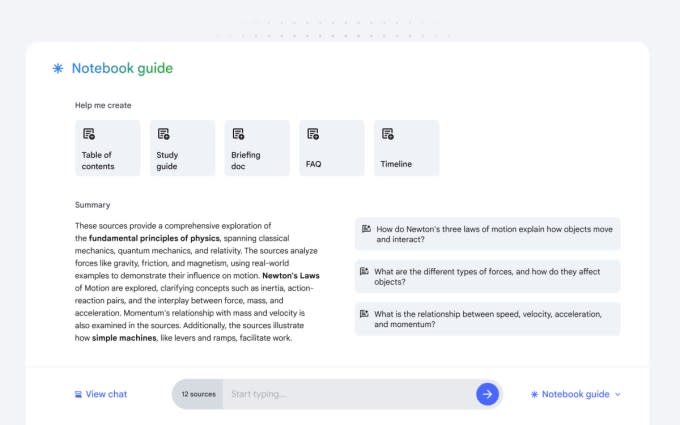Google on Thursday said it is rolling out NotebookLM, its AI-powered note-taking assistant, to over 200 new countries, nearly six months after opening its access in the U.S. The platform, powered by Google’s multimodal LLM Gemini 1.5 Pro, has also been upgraded with new features and languages to help more people use AI to generate summaries and ask questions based on their documents.
The list of countries that NotebookLM now supports includes Australia, Brazil, Canada, India, and the U.K., as well as 208 other countries and territories. Google has also broadened the interface language support for the AI-assisted app to 108 languages, including Arabic, Assamese, Bengali, Cantonese, Chinese, Dutch, French, German, Hindi and Hinglish. It also supports sources and chat in 38 languages, such as Arabic, Bengali, Chinese (simplified and traditional), Dutch, French, German, Hindi, Japanese, and Spanish.
NotebookLM, first demoed as Project Tailwind at Google I/O in 2023, was initially available to a select few users in June last year. It uses AI to help generate summaries and answer questions from documents, transcripts, notes and other sources that users can upload. This is unlike a traditional AI chatbot, like ChatGPT, which often does not adhere to the source users provide and generates information based on the data used for its training that sometimes can be unrelated or wrong.
Google is also giving NotebookLM the ability to source content from Google Slides and web URLs, in addition to the existing support for Google Docs, PDFs and text files. This lets users create notes or ask questions about the content (whether it is an image or text) in their documents or explore online material.
Some early users of NotebookLM in the U.S. anticipated it would support traditional note-taking apps, including Evernote and Google Keep. However, Raiza Martin, senior product manager for AI at Google Labs, told TechCrunch in a virtual roundtable earlier this week that Google wanted to focus on the product’s core value before expanding integrations.
“Down the road, you’ll hopefully see these types of integrations,” she said.
Google has also added inline citations to help you look at supporting passages in your sources, fact-check AI-generated responses, and read the original text for more context. Previously, citations were located below the responses the assistant generated.
It also comes with Notebook Guide, which helps convert your content into various formats, such as FAQs, briefing documents or study guides.

Google Labs’ editorial director, Steven Johnson, said NotebookLM was developed with authors, students and educators, and the company saw early adopters integrating its source-grounding architecture into their research and writing workflows.
The company said NotebookLM has also been used for creating hyperlocal newsletters, summarizing interview transcripts, developing grant proposals, or even managing descriptions of fantasy worlds.
Martin noted that Google does not use any of the data users upload on NotebookLM to train its algorithms.
“In particular, we get this question a lot because users want to be able to use it with work or school documents,” she said. “Your data does stay private to you.”
At its Google I/O 2024 keynote in May, Google showed off an early prototype of Audio Overviews for NotebookLM that uses the company’s Gemini model to scan through the uploaded materials and generate a podcast-esque discussion. Gemini 1.5 Pro also lets NotebookLM have up to 50 sources in each notebook, with 500,000 words per source.
The global rollout of NotebookLM will likely pit it directly against the dozens of platforms (read startups) that currently let users use GenAI tools to do things like answer their questions and summarize PDFs tools. Most of these platforms charge for their services, but Google’s heft is allowing it to offer this service for free.

